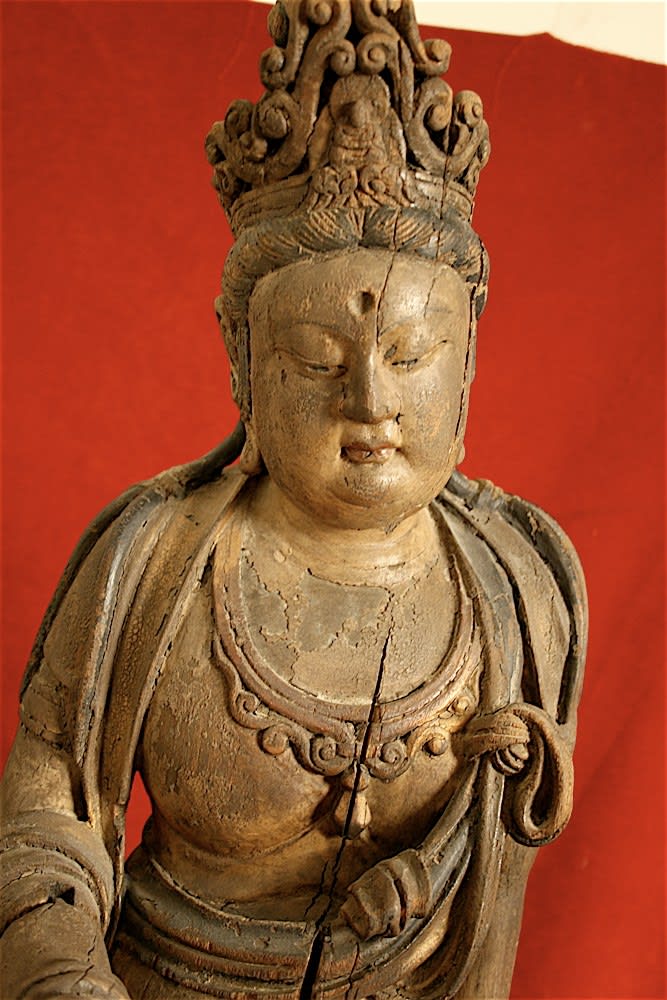Ming Standing Wooden Bodhisattva, 1369 CE - 1644 CE
Wood
39.37
PF.1500DC (LSO)
Further images
This elegant masterwork represents a Bodhisattva Guanyin – an enlightened being who chooses not to enter Nirvana, preferring to help others attain the necessary enlightenment to do so. Indeed, she...
This elegant masterwork represents a Bodhisattva Guanyin – an enlightened being who chooses not to enter Nirvana, preferring to help others attain the necessary enlightenment to do so. Indeed, she is known to the West as the Goddess of Compassion. They are usually very ornate, and in this sense all the Bodhisattvas differ from representations of Buddhas, who eschew such worldly displays in favour of ascetic simplicity.
This piece is carved from solid hardwood, and shows the Bodhisattva in a standing posture with the left arm by the side and other extended and the hand making the gesture of vitarka mudra. In the “language” of hand positions in Buddhist imagery, this is a teaching mudra, which the Buddha or other informed individuals used while imparting knowledge about Buddhism. It has been argued that the standard virtarka mudra is done with the index finger, and that the three remaining fingers, when in contact with the thumb, imply the teaching of the second, third and fourth Noble Truths. In this case, the central finger is being used, and the sculpture may thus refer to the teaching of the second of the four Noble Truths: “the origin of suffering is attachment”. The face is fleshy and impassive, with lifelike rendering of the cheeks, jowls and facial features. The remainder of the figure is characteristic of the genre, with ornate jewellery around the neck, wrists, biceps and in the ears. The figure is dressed in extensive and beautifully-carved drapery brought together at the waist and left side of the chest, and hanging over the right arm.
Established in 1368, the M’ing dynasty was founded by Hong Wu, one of only three peasants ever to rise to imperial pre-eminence. His attitudes towards rule reflected his own past, with considerable emphasis on agricultural production, an aversion to trade, a massive expansion of military power and spending a fortune on defences (notably the Great Wall). This philosophy, while partly reflexive, was based loosely upon Confucianism, with which China had had a love-hate relationship for much of the preceding millennium. The inevitable effect of Hong Wu’s policies was stability, and with it the rise and rise of the middle classes. While in many respects a martially vigorous and ascetic time, the enormous wealth generated by agricultural surpluses led to an unexpected flowering of arts under the patronage of what was essentially the nouveau riche, who liked to surround themselves with artworks including lacquer work, paintings, prestige ceramics and sculptures both for this life and for the hereafter (mingqi). Imposing figures such as this come under the former category, and were typically displayed in temples and perhaps the private homes of the elites.
This is a beautifully-rendered and highly sophisticated piece of ancient Chinese art.
This piece is carved from solid hardwood, and shows the Bodhisattva in a standing posture with the left arm by the side and other extended and the hand making the gesture of vitarka mudra. In the “language” of hand positions in Buddhist imagery, this is a teaching mudra, which the Buddha or other informed individuals used while imparting knowledge about Buddhism. It has been argued that the standard virtarka mudra is done with the index finger, and that the three remaining fingers, when in contact with the thumb, imply the teaching of the second, third and fourth Noble Truths. In this case, the central finger is being used, and the sculpture may thus refer to the teaching of the second of the four Noble Truths: “the origin of suffering is attachment”. The face is fleshy and impassive, with lifelike rendering of the cheeks, jowls and facial features. The remainder of the figure is characteristic of the genre, with ornate jewellery around the neck, wrists, biceps and in the ears. The figure is dressed in extensive and beautifully-carved drapery brought together at the waist and left side of the chest, and hanging over the right arm.
Established in 1368, the M’ing dynasty was founded by Hong Wu, one of only three peasants ever to rise to imperial pre-eminence. His attitudes towards rule reflected his own past, with considerable emphasis on agricultural production, an aversion to trade, a massive expansion of military power and spending a fortune on defences (notably the Great Wall). This philosophy, while partly reflexive, was based loosely upon Confucianism, with which China had had a love-hate relationship for much of the preceding millennium. The inevitable effect of Hong Wu’s policies was stability, and with it the rise and rise of the middle classes. While in many respects a martially vigorous and ascetic time, the enormous wealth generated by agricultural surpluses led to an unexpected flowering of arts under the patronage of what was essentially the nouveau riche, who liked to surround themselves with artworks including lacquer work, paintings, prestige ceramics and sculptures both for this life and for the hereafter (mingqi). Imposing figures such as this come under the former category, and were typically displayed in temples and perhaps the private homes of the elites.
This is a beautifully-rendered and highly sophisticated piece of ancient Chinese art.





